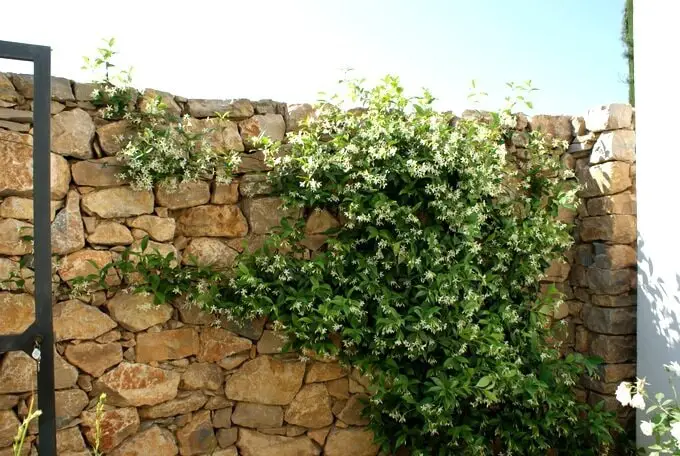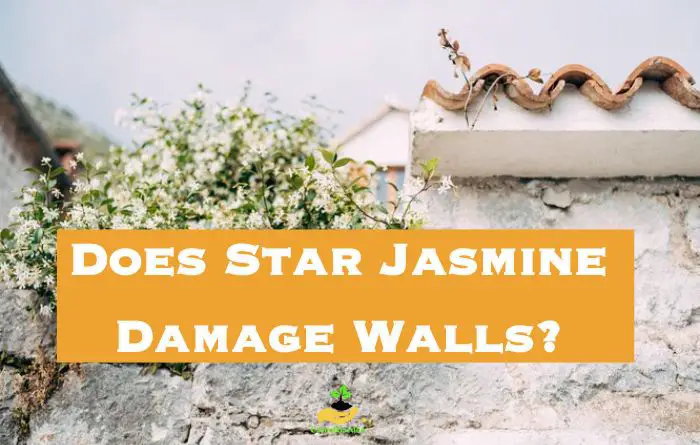Does Star Jasmine Damage Walls? (Quick Answer Here)
As a homeowner and avid gardener, I have always been fascinated by the beauty and fragrance of star jasmine. However, I have also heard conflicting opinions about whether or not this climbing plant can cause damage to walls and other structures.
In this article, I will answer the question of whether star jasmine can harm walls and provide some insights based on my own experience and research.
Star jasmine, while not known to cause direct damage to walls, can leave behind residue and stains if not properly maintained. However, in older or weaker walls star jasmine’s tendrils can penetrate cracks and weaken the structure over time. Although it can grow quickly and become large, regular pruning can prevent any potential damage. By keeping the plant trimmed and away from walls, you can ensure that it does not cause harm.
Impact of Star Jasmine on Walls
Star Jasmine is a vine-like plant that can grow up to 20 feet in height and 10 feet in width. It attaches itself to surfaces using tendrils that wrap around anything they come into contact with. This can include walls, trellises, and trees.
While this can be a beautiful addition to any garden or landscape, it is important to consider the potential damage it can cause to the structure it is climbing on.
| Impact of Star Jasmine on Walls | Description |
|---|---|
| Attachment and Clinging | Star jasmine’s tendrils and aerial roots allow it to attach and climb walls. |
| Surface Discoloration | Dense growth against walls can create a moist microenvironment, leading to potential discoloration, staining, or algae/mold growth. |
| Mortar and Joint Disruption | Over time, tendrils and roots can penetrate cracks or crevices in masonry, brick, or stone walls, potentially disrupting mortar joints. |
| Damage to Paint or Coatings | Improper removal of star jasmine vines clinging to painted or coated surfaces may cause damage to the paint or protective coatings. |
| Maintenance and Repair Challenges | Removing deeply rooted or extensively attached star jasmine may require care to avoid wall damage. Repairing or repainting affected walls can pose challenges. |
https://gardening.stackexchange.com/questions/20687/vines-crawling-plants-that-minimize-damage-to-buildings-walls
The tendrils of star jasmine can attach themselves to walls and other structures, causing damage over time. This can include cracks in the wall, damage to paint or other finishes, and even structural damage if the plant becomes too heavy.
It is important to consider the age and condition of the wall or structure before planting star jasmine.
When star jasmine is grown on a wall or other structure, it can cause damage over time. The plant’s tendrils can grow into cracks and crevices in the wall, causing it to weaken and potentially crack further.
This can be especially problematic for older or weaker walls that may not be able to withstand the weight of the plant.
From my experience, in addition to physical damage, star jasmine can also cause aesthetic damage to walls by leaving behind residue and stains from its sap, which can be difficult to remove. This is the case for walls that are painted or otherwise finished.
To mitigate the potential impact of star jasmine on walls, it is important to provide proper support and spacing for the plant.
Trellises and other structures should be sturdy and able to support the weight of the plant. Jasmine should also be spaced appropriately to prevent it from growing into cracks or causing other damage.
Table showcasing impact of star jasmine on different types of walls
| Wall Material | Potential Effects of Jasmine |
|---|---|
| Masonry, Brick, or Stone | – Disruption of mortar joints |
| – Moisture retention leading to deterioration | |
| – Discoloration and staining- | |
| Wood or Timber Surfaces | – Decay and rot due to trapped moisture |
| – Weakening of wooden structures | |
| – Damage to paint or coatings | |
| – Potential for insect infestation | |
| Rendered or Painted Walls | – Adhesion issues with render or paint |
| – Discoloration or staining of painted surfaces | |
| – Trapped moisture leading to mold or mildew growth | |
| – Degradation of surface finishes |
https://www.gardenersworld.com/how-to/grow-plants/how-to-grow-jasmine/
https://gardenforindoor.com/training-star-jasmine-on-trellis/
Factors Influencing the Severity of Wall Damage

When it comes to determining the severity of wall damage caused by Star Jasmine, there are several factors to consider.
As someone who has grown and cared for Star Jasmine, I have found that the following factors can have a significant impact on the extent of damage caused by this plant:
Growth and Attachment Duration
Star Jasmine is a vigorous plant that can grow and spread quickly. If left unattended, it can attach itself firmly to walls and other structures, causing damage over time.
The longer you leave your start jasmine grow on a wall, the more difficult it can be to remove without causing further damage.
Climatic Conditions and Environmental Factors
Star Jasmine thrives in warm, humid environments with plenty of sunlight. In full sun, the plant can grow more vigorously, making it more likely to cause damage to walls.
In partial shade, the growth rate may be slower, but the plant can still attach itself firmly to walls and cause damage over time.
Wall Maintenance and Preventative Measures
Regular wall maintenance can help to prevent damage caused by Star Jasmine. This includes cleaning the wall regularly to remove any dirt or debris that may accumulate, as well as repairing any cracks or damage to the wall as soon as they are noticed.
Installing a trellis or other support for the plant can also help to prevent damage caused by direct contact with the wall.
Fertilizing and pruning are also important aspects of Star Jasmine care. Fertilizing once a year in early spring and pruning after the plant has finished blooming can help promote healthy growth and prevent it from becoming too overgrown.
When it comes to training and spacing, it’s important to give Star Jasmine enough room to grow without becoming too crowded. A spacing of at least 3 feet is recommended between your jasmines.
Other Factors
Other factors that can influence the severity of wall damage caused by Star Jasmine include soil type, watering and fertilization practices, pruning and training techniques, temperature and humidity levels, and the hardiness zone in which the plant is located.
Proper care and maintenance of the plant can help to minimize the risk of damage to walls and other structures.
How to Prevent Wall Damage from Start Jasmine
Here are steps I recommend you do to prevent wall damage caused by star jasmine:
- Proper Planting and Site Selection:
- Choose suitable support structures: Install sturdy trellises, wires, or other support systems that guide the growth of star jasmine vines away from direct wall contact.
- Maintain adequate distance: Plan for sufficient space between the planting location of star jasmine and the walls to allow for proper airflow and minimize attachment.
- Perform Pruning and Training:
- Regular pruning: Trim and prune star jasmine to manage its growth, prevent excessive weight, and control its spread towards the walls.
- Direct growth away from walls: Train the vines to grow horizontally or upward, away from the walls, by gently guiding the tendrils or branches.
- Add Physical Barriers:
- Install barriers: Place physical barriers between the star jasmine and the walls to prevent direct contact. Use materials such as mesh screens, lattice, or netting to create a buffer zone.
- Use freestanding structures: Consider using freestanding pergolas, arbors, or fences to provide support for the star jasmine while keeping it away from the walls.
- Regular Monitoring and Maintenance:
- Inspect walls regularly: Conduct visual inspections to check for any signs of attachment, damage, or stress caused by star jasmine growth. Promptly address any issues.
- Remove tendrils or roots: Regularly inspect the vines and gently remove any tendrils or aerial roots that are attaching to the walls to prevent further attachment and potential damage.
- Wall Maintenance:
- Address existing wall issues: Repair any existing cracks, weaknesses, or structural problems in the walls to minimize vulnerability to potential damage.
- Apply protective coatings: Consider applying protective coatings or sealants to the walls to provide an additional layer of defense against potential moisture retention or staining.
Conclusion
Overall, understanding Star Jasmine’s growth habits is crucial to ensuring that it doesn’t damage walls or other surfaces.
By providing the right conditions and care, this beautiful plant can thrive and add beauty to any garden or outdoor space.
Frequently Asked Questions
No, star jasmine is not considered destructive. While it can attach itself to surfaces using tendrils and aerial roots, it is typically well-behaved and does not cause significant damage.
To clean Star Jasmine residue from walls, you can use a mixture of warm water and mild detergent. Apply the solution to the affected area and scrub gently with a soft-bristled brush. Rinse the area with clean water and let it air dry.
Star Jasmine can be grown on any type of wall as long as it is sturdy enough to support the weight of the plant. It is important to note that the plant should not be grown on walls made of materials that are easily damaged by moisture, such as wood.
Yes, star jasmine (Trachelospermum jasminoides) has a natural tendency to cling and climb surfaces, including walls. It uses tendrils and aerial roots to attach itself to various structures.
Yes, if not properly maintained, star jasmine can leave behind residue and stains. This is more common in areas where the plant’s growth is dense and retains moisture against the wall surface.




